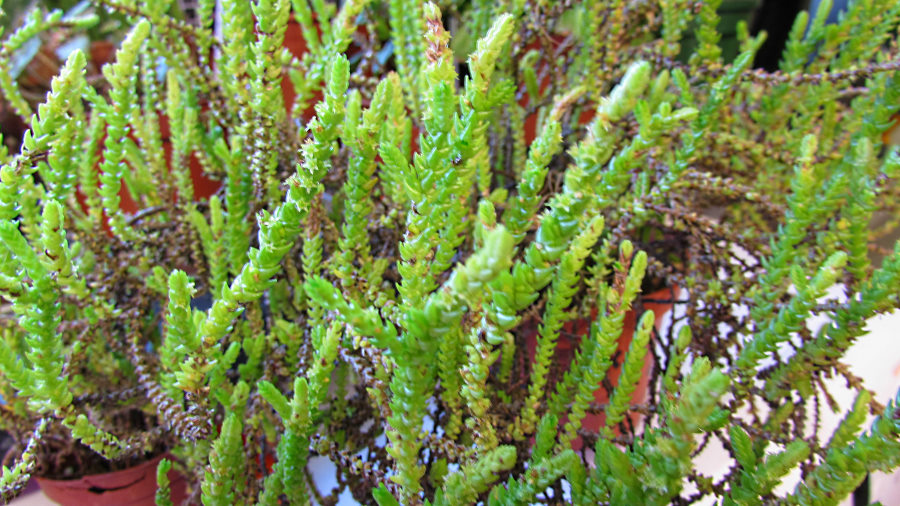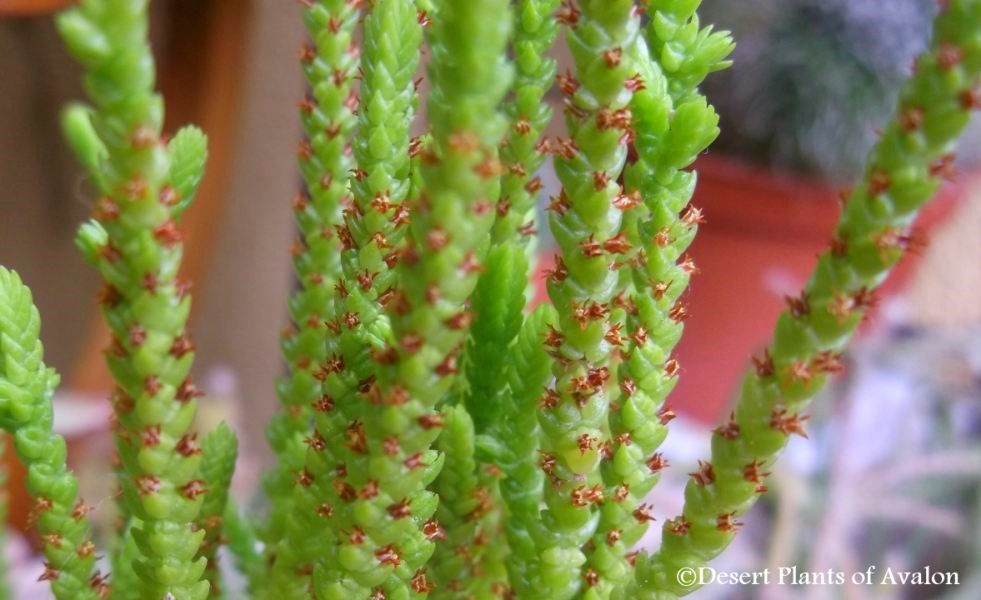Hi Plant Lovers 😀
In this Blog / Article I will be talking about the very wonderful Crassula muscosa Succulent Plant aka Crassula muscosa, Crassula lycopodioides, Crassula pseudolycopodioides, and more commonly The Watch Chain Plant.

I have made a special video on my You Tube Channel called Desert Plants of Avalon on How to Care for and Grow Crassula muscosa and you can watch this video below:
ABOUT:
Crassula muscosa grows in its natural habitats in South Africa in the Winter & Summer rainfall areas of the Western and Eastern Cape growing in well draining rocky quartz fields.
Crassula muscosa is a spreading growing Succulent Plant that can grow fast during the growing period, as the plant grows larger its common for stem segments to drop off and root readily where they land, and you can often see the stem segments that has dropped off growing in nearby plant pots or nearby places in your yard and garden.
Commonly called the Watch Chain Plant because of its tiny tight rosette leaf arrangements resembling the links of a jewellery chain and a watch chain, the word muscosa is Latin for ‘mossy’ due to this plants moss like appearance.
This plant is commonly sold and seen for sale as part of a plant and succulent bowl garden arrangement.
My Crassula muscosa plant ( pictured above) was also part of a plant arrangement that my friend gave to me over 12 years ago.
LIGHT:
Grows best in full sun or in very bright light, a sunny window or patio or other sunny and bright position is ideal, but if grown in intense midday sun in the Summer plenty of ventilation should be given, too little sun or too much intense sun without ventilation can cause leaf segments to go brown and hard and woody and they will drop off more readily, these plants grow well under full spectrum LED plant grow lights if you don’t have a sunny window or position to place them in.
SOIL:
Like all succulents these plants need a very well draining soil so that the soil can drain easily and does not stay too wet for long, a good quality commercial cactus & succulent soil can be used, or you can make up your own using 3 equal parts of Loam, grit (or perlite) and horticultural sand. If you want to know how to make your own soil for cacti and succulents then check the video below I have made for my You Tube Channel called Desert Plants of Avalon on How to make your own soil for cacti and succulents in 3 easy steps:
WATER:
Spring and Summer and early Fall water every time the soil in the pot has dried out, in my experience these plants can take a lot more watering in Spring Summer and Fall, but ideally its best to allow the soil to dry in between waterings,
in late Fall and Winter its best to keep these plants more on the dry side and a good watering once a month is plenty, although this plant is Winter flowering it is not Winter growing and does not need to be watered as regularly, once a month is best, if you are growing these plants indoors on a sunny window and indoor house temperatures you may need to water them twice a month in Winter if they start to go limp or drop segments, but remember if in doubt its safer to under rather than over water.
FERTILISER:
In Spring and Summer fertilise these plants once every 2-3 weeks with a good quality fertiliser especially for Cacti and Succulents, in Winter there is no need to fertilise even when these plants are in Winter flower, because although these plants are winter flowering they are not winter growing.
RE POTTING:
Re pot in Spring and Summer or early Fall into a pot the next size up, plant into well draining cactus and succulent soil, after repotting its best to wait a few days before watering again to allow any roots to settle into the soil.
TEMPERATURE:
In Spring and Summer a good temperature is around 70-75 Fahrenheit / 21-24 Celsius, they can take higher temperatures than this as long as long as plenty of ventilation can be given, open windows if growing on windowsills indoors on very hot summer days or install a circulating fan in hot greenhouses.
In Winter these plants can take very cold temperatures and is hardy to 20 Fahrenheit / -7 Celsius but ideally a temperature around 41 Fahrenheit / 5 Celsius is a safer minimum temperature for these plants in Winter.
HUMIDITY:
Like all succulent plants they don’t like high humidity as this can encourage fungus and rots, plenty of ventilation must always be given in very hot and wet weather, the ideal humidity for these plants is 50% or lower, but they can take much higher than this if the soil is allowed to dry out in between watering, and the soil is kept much drier in Winter.
FLOWERING:
Crassula muscosa is a Winter flowering succulent, although it is not uncommon to see these plants flower in the Spring, Summer and Fall too.

The miniature flowers start off white and then turn brown as they age and are absolutely tiny, in fact most growers don’t even notice the extremely tiny blooms on these plants and the rather unusual strange scent of the blooms are often noticed before the flowers are seen.
The miniature blooms smell musty and soapy and the scent of these blooms is hard to compare to anything else, its a scent you either love or hate haha.
If you want to see what the blooms on Crassula muscosa look like up close then check out my video on my You Tube Channel called Desert Plants of Avalon of my Crassula muscosa in Bloom, you can watch this video below:
PRUNING:
Crassula muscosa is best pruned every year in Spring to help prevent the stems from growing unruly and pruning this plant back also helps to prevent the stems from dropping off from the weight of the stems as they grow.
These plants can be easily re started again as cuttings if the stems start to look too dry and brown.
PROPAGATION:
These plants are very easy to propagate especially when pruning the stems in spring, cuttings root very readily in water, its always best to root cuttings in Spring and summer, just place the cuttings into a cup of about an inch of water and they will send out roots within 2-6 weeks, you can also plant the cuttings directly into well draining soil.
I have made a video on my You Tube Channel called Desert Plants of Avalon on How to take cuttings and Propagate Crassula muscosa and you can watch this video below:
PESTS & DISEASES:
The most common insect pests you are likely to see are mealy bugs, thrips, scale insect and the like, If I spot pests on my plants I like to use Horticultural Neem oil mixed with Horticultural soap and spray the plant/s thoroughly once a week for 6 weeks until no signs of the pests remain.
Fungus and root rot are the most common types of diseases on succulent plants although thankfully not that common on Crassula muscosa, root rot is best corrected by taking cuttings and re starting the plant, but if fungus is a problem its best to treat the whole plant with Horticultural Neem oil mixed with Horticultural soap and spray the whole plant thoroughly every week for a month.
I have made a video on my You Tube Channel called Desert Plants of Avalon on How to use Neem oil to treat insect pests and diseases on Succulent plants and you can watch this video below:
I hope you enjoyed this article on how to grow Crassula muscosa, and for lots more tips and tricks on how to care for and grow Cacti and Succulents please check out my You Tube Channel called Desert Plants of Avalon.
Thank you for reading and have a wonderful plant powered day <3